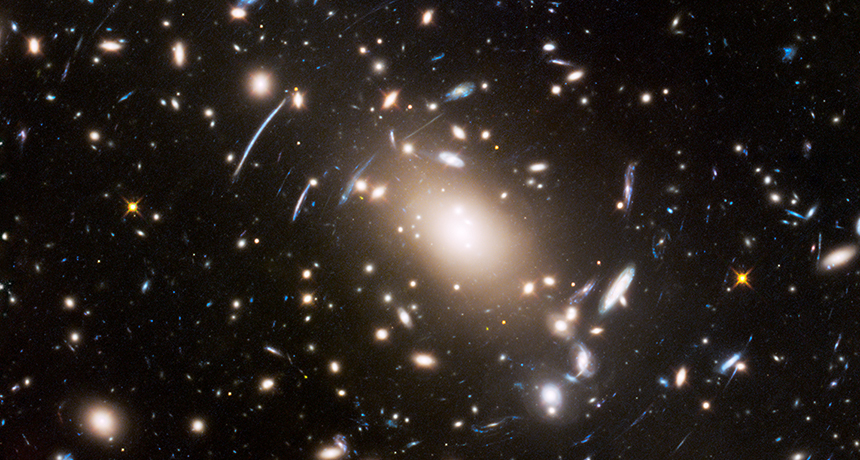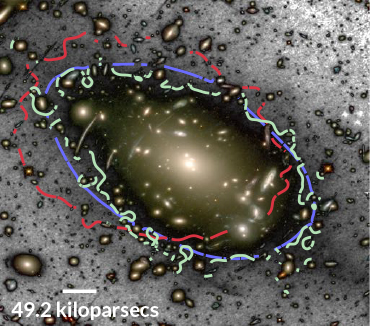
LIGHTING THE DARK A feeble glare known as intracluster light traces the location of dark matter within galaxy clusters such as Abell S1063 (shown).
J. Lotz/STScl, ESA, NASA
Dim light emanating from the purgatory between galaxies could illuminate the most shadowy constituents of the cosmos.
Dark matter, an unidentified type of particle that interacts gravitationally but otherwise shuns normal matter, lurks throughout clusters of galaxies. Because the elusive substance emits no light, it’s difficult to pin down how it is distributed, even though it makes up the majority of a cluster’s mass. But a feeble glow known as intracluster light could reveal dark matter’s whereabouts, researchers suggest July 30 at arXiv.org. The intermediary could eventually help scientists get a better handle on what dark matter is and how it behaves.
Galaxy clusters grow by swallowing up additional galaxies. As galaxies are assimilated, they can be torn apart and their stars scattered. It’s those stars that produce intracluster light. And where there’s intracluster light, there’s dark matter, the team found. “The shape of this very diffuse light traces very nicely the shape of the total mass of the cluster,” says study coauthor Mireia Montes, an astrophysicist at the University of New South Wales in Sydney. Once stripped from their galaxies, the stars are tugged by the dark matter’s gravity and thereby end up concentrated in the same regions as it resides.
Typically, scientists use an effect called gravitational lensing to map dark matter (SN: 10/17/15, p. 24). A galaxy cluster’s mass acts like a lens, bending light from more distant objects. By measuring that bending, scientists can see how the dark matter’s mass is distributed within the cluster. However, “that is an incredibly hard measurement to make,” says astrophysicist Stacy Kim of Ohio State University, who was not involved with the research. Measuring intracluster light is easier, Kim says, but teasing out the faint light is still challenging, requiring extended observations with a powerful telescope.
Scientists sometimes use another proxy for dark matter: X-rays emitted by hot gas within a cluster. But if a galaxy cluster has recently merged with another, collisions between gas clouds mean that the X-rays will be displaced from the dark matter. So a map of the matter made using X-rays might be skewed. The stars that produce intracluster light don’t have that problem, because they don’t get knocked off course in cluster mergers the way colliding gas clouds do.
In a study of six galaxy clusters, each observed with NASA’s Hubble Space Telescope, the researchers found that the distribution of intracluster light matched up well with the dark matter mass distribution as determined by gravitational lensing. The X-ray distribution didn’t match, because the six clusters had each been roiled by a recent smashup with another cluster. The team hopes to study more clusters to see if the match between dark matter and intracluster light holds up.
By measuring intracluster light, scientists could “perhaps learn something about the nature of dark matter,” says astrophysicist James Bullock of the University of California, Irvine, who was not involved with the research.
If the distribution of dark matter in galaxy clusters doesn’t agree with standard theoretical predictions, that could reveal new properties of the unidentified particles. For example, dark matter might be interacting with itself (SN: 7/7/18, p. 9). So having a new method to trace out dark matter is great, Bullock says. “This is definitely promising.”








